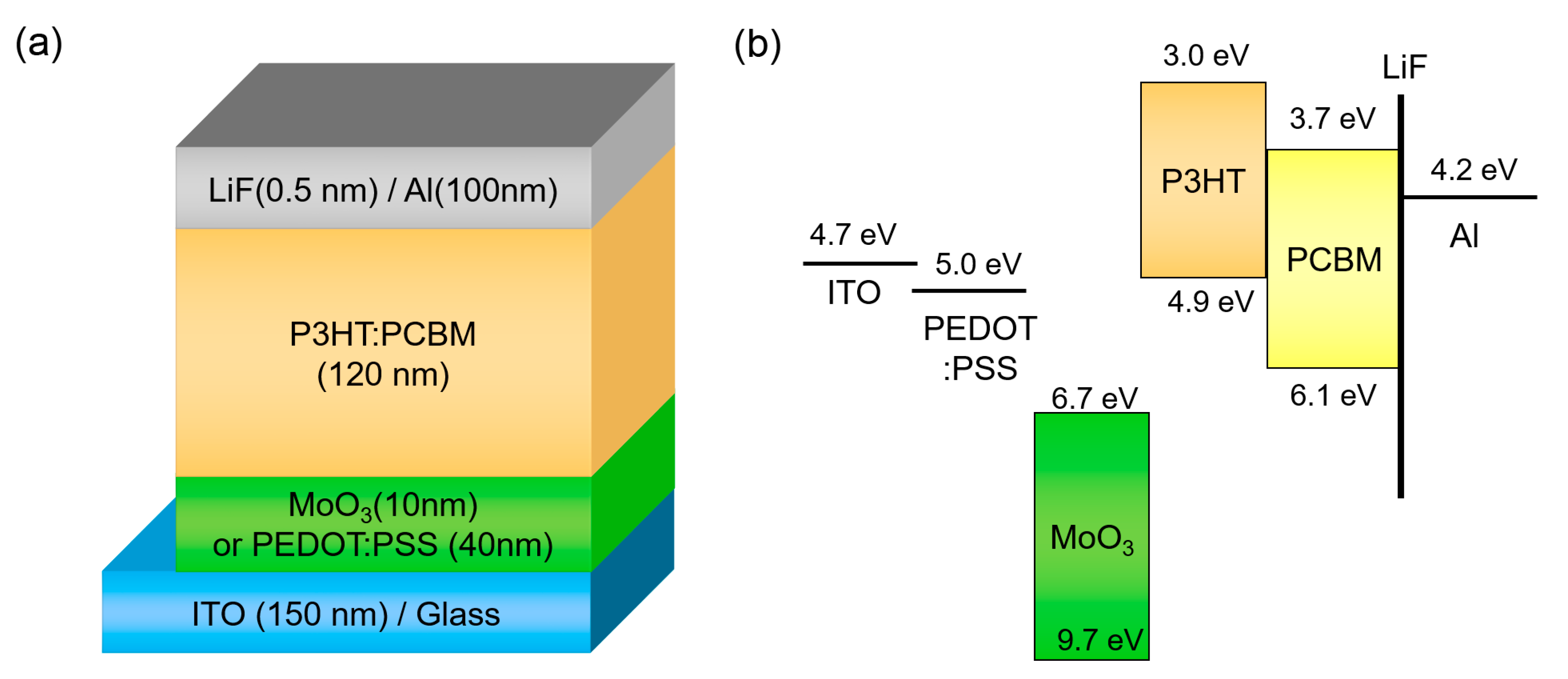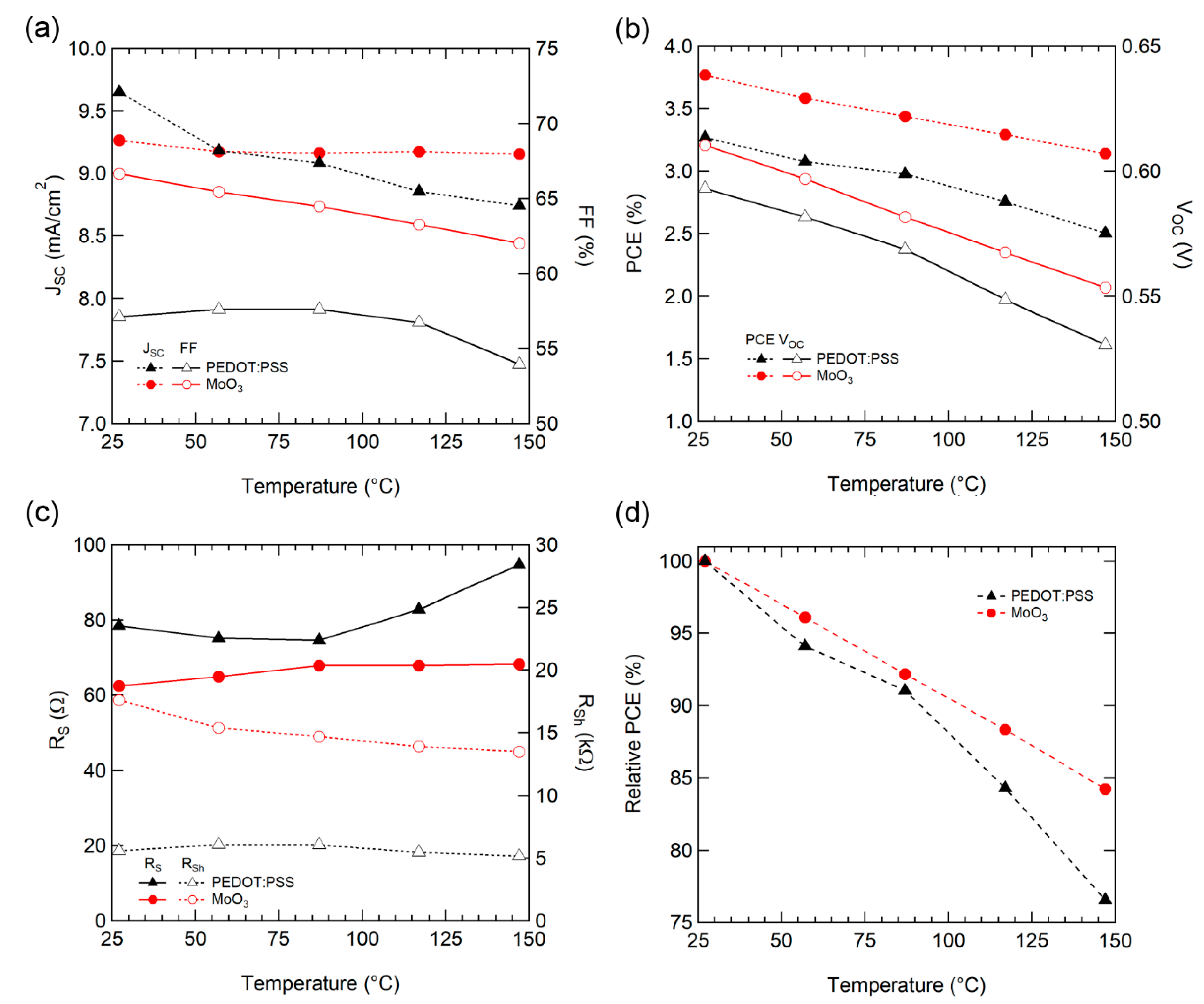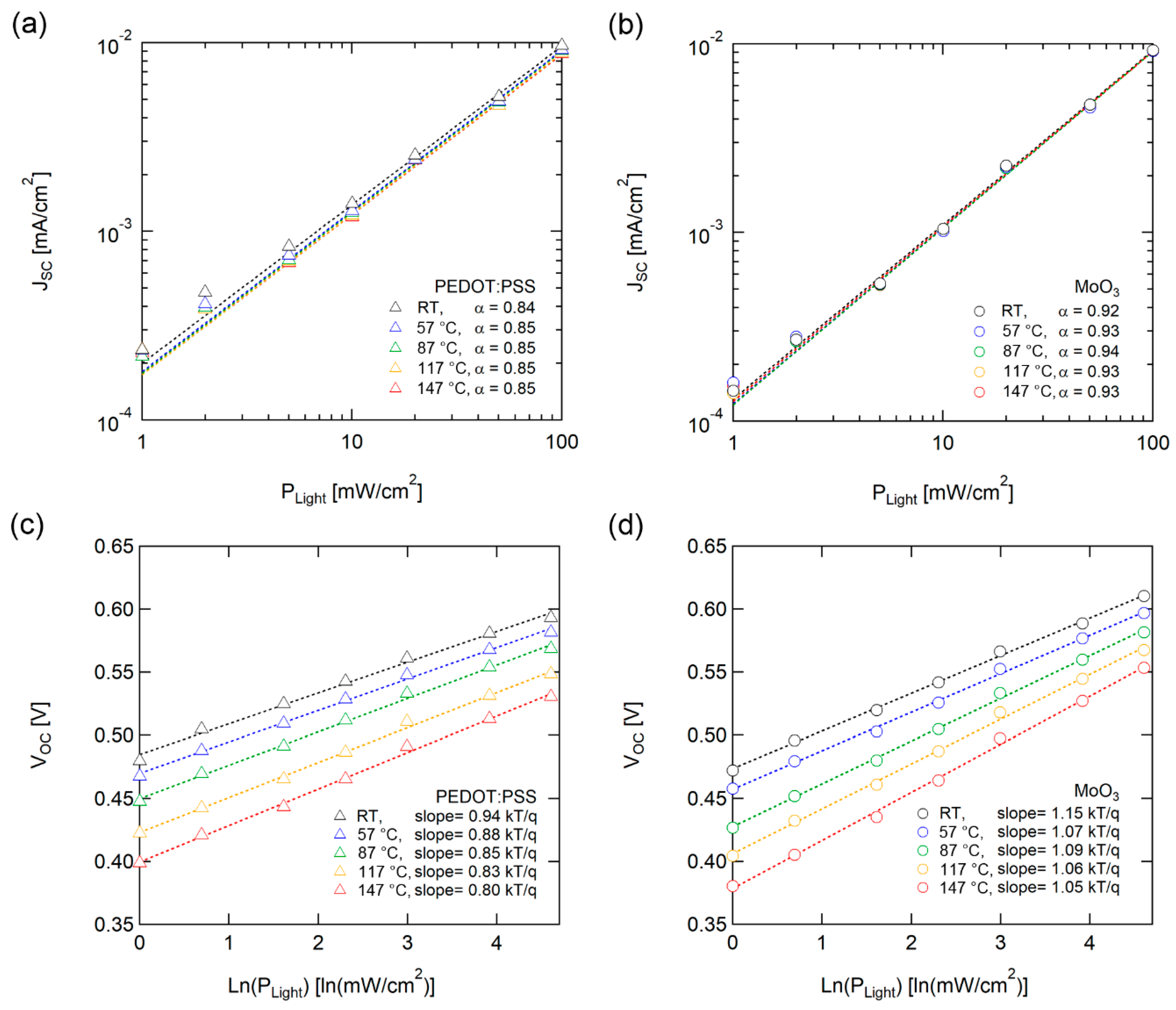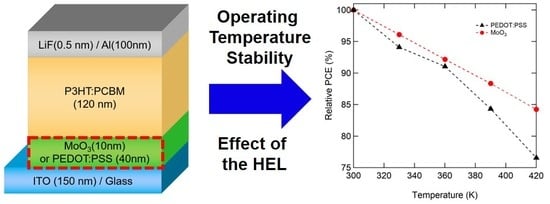Enhanced Operating Temperature Stability of Organic Solar Cells with Metal Oxide Hole Extraction Layer
Abstract
:1. Introduction
2. Materials and Methods
3. Results and Discussion
4. Conclusions
Supplementary Materials
Author Contributions
Funding
Conflicts of Interest
References
- Tang, C.W. 2-layer organic photovoltaic cell. Appl. Phys. Lett. 1986, 48, 183–185. [Google Scholar] [CrossRef]
- Forrest, S.R. The path to ubiquitous and low-cost organic electronic appliances on plastic. Nature 2004, 428, 911–918. [Google Scholar] [CrossRef] [PubMed]
- Li, G.; Zhu, R.; Yang, Y. Polymer solar cells. Nat. Photon. 2012, 6, 153–161. [Google Scholar] [CrossRef]
- Nielsen, T.D.; Cruickshank, C.; Foged, S.; Thorsen, J.; Krebs, F.C. Business, market and intellectual property analysis of polymer solar cells. Sol. Energy Mater. Sol. Cells 2010, 94, 1553–1571. [Google Scholar] [CrossRef]
- Dennler, G.; Scharber, M.C.; Brabec, C.J. Polymer-Fullerene Bulk-Heterojunction Solar Cells. Adv. Mater. 2009, 21, 1323–1338. [Google Scholar] [CrossRef]
- Chen, H.-Y.; Hou, J.; Zhang, S.; Liang, Y.; Yang, G.; Yang, Y.; Yu, L.; Wu, Y.; Li, G. Polymer solar cells with enhanced open-circuit voltage and efficiency. Nat. Photon. 2009, 3, 649–653. [Google Scholar] [CrossRef]
- Cui, Y.; Yao, H.; Zhang, J.; Zhang, T.; Wang, Y.; Hong, L.; Xian, K.; Xu, B.; Zhang, S.; Peng, J.; et al. Over 16% efficiency organic photovoltaic cells enabled by a chlorinated acceptor with increased open-circuit voltages. Nat. Comm. 2019, 10, 2515. [Google Scholar] [CrossRef]
- Bin, H.; Gao, L.; Zhang, Z.-G.; Yang, Y.; Zhang, Y.; Zhang, C.; Chen, S.; Xue, L.; Yang, C.; Xiao, M.; et al. 11.4% Efficiency non-fullerene polymer solar cells with trialkylsilyl substituted 2D-conjugated polymer as donor. Nat. Comm. 2016, 7, 13651. [Google Scholar] [CrossRef] [Green Version]
- Liu, J.; Chen, S.; Qian, D.; Gautam, B.; Yang, G.; Zhao, J.; Bergqvist, J.; Zhang, F.; Ma, W.; Ade, H.; et al. Fast charge separation in a non-fullerene organic solar cell with a small driving force. Nat. Energy 2016, 1, 16089. [Google Scholar] [CrossRef]
- Cheng, P.; Li, G.; Zhan, X.; Yang, Y. Next-generation organic photovoltaics based on non-fullerene acceptors. Nat. Photon. 2018, 12, 131–642. [Google Scholar] [CrossRef]
- Yu, G.; Gao, J.; Hummelen, J.C.; Wudl, F.; Heeger, A.J. Polymer photovoltaic cells: Enhanced efficiencies via a network of internal donor–acceptor heterojunctions. Science 1995, 270, 1789–1791. [Google Scholar] [CrossRef] [Green Version]
- Campoy-Quiles, M.; Ferenczi, T.; Agostinelli, T.; Etchegoin, P.G.; Kim, Y.; Anthopoulos, T.D.; Stavrinou, P.N.; Bradley, D.D.C.; Nelson, J. Morphology evolution via self-organization and lateral and vertical diffusion in polymer:fullerene solar cell blends. Nat. Mater. 2008, 7, 158–164. [Google Scholar] [CrossRef] [PubMed]
- Park, S.H.; Roy, A.; Beaupré, S.; Cho, S.; Coates, N.; Moon, J.S.; Moses, D.; Leclerc, M.; Lee, K.; Heeger, A.J. Bulk heterojunction solar cells with internal quantum efficiency approaching 100%. Nat. Photon. 2009, 3, 297–303. [Google Scholar] [CrossRef]
- Kim, J.Y.; Lee, K.; Coates, N.E.; Moes, D.; Nguyen, T.-Q.; Dante, M.; Heeger, A.J. Efficient tandem polymer solar cells fabricated by all-solution processing. Science 2007, 317, 222–225. [Google Scholar] [CrossRef] [PubMed] [Green Version]
- Lee, D.; Bae, W.K.; Park, I.; Yoon, D.Y.; Lee, S.; Lee, C. Transparent electrode with ZnO nanoparticles in tandem organic solar cells. Sol. Energy. Mater. Sol. Cells. 2011, 95, 365–368. [Google Scholar] [CrossRef]
- Meng, L.; Zhang, Y.; Wan, X.; Li, C.; Zhang, X.; Wang, Y.; Ke, X.; Xiao, Z.; Ding, L.; Xia, R.; et al. Organic and solution-processed tandem solar cells with 17.3% efficiency. Science 2018, 361, 1094. [Google Scholar] [CrossRef] [PubMed] [Green Version]
- Yuan, J.; Zhang, Y.; Zhou, L.; Zhang, G.; Yip, H.L.; Lau, T.K.; Lu, X.; Zhu, C.; Peng, H.; Johnson, P.A.; et al. Single-Junction Organic Solar Cell with over 15% Efficiency Using Fused-Ring Acceptor with Electron-Deficient Core. Joule 2019, 3, 1140. [Google Scholar] [CrossRef]
- Zhang, S.; Qin, Y.; Zhu, J.; Hou, J. Over 14% Efficiency in Polymer Solar Cells Enabled by a Chlorinated Polymer Donor. Adv. Mater. 2018, 30, 1800868. [Google Scholar] [CrossRef]
- Cheng, P.; Yan, C.; Lau, T.-K.; Mai, J.; Zhan, X. Molecular Lock: A Versatile Key to Enhance Efficiency and Stability of Organic Solar Cells. Adv. Mater. 2016, 28, 5822–5829. [Google Scholar] [CrossRef]
- Cheng, P.; Yan, C.; Wu, Y.; Wang, J.; Qin, M.; An, Q.; Cao, J.; Huo, L.; Zhang, F.; Ding, L.; et al. Alloy Acceptor: Superior Alternative to PCBM toward Effi cient and Stable Organic Solar Cells. Adv. Mater. 2016, 28, 8021–8028. [Google Scholar] [CrossRef]
- Jørgensen, M.; Norrman, K.; Gevorgyan, S.A.; Tromholt, T.; Andreasen, B.; Krebs, F.C. Stability of Polymer Solar Cells. Adv. Mater. 2011, 24, 580–612. [Google Scholar] [CrossRef]
- Park, J.H.; Lee, T.-W.; Chin, B.-D.; Wang, D.H.; Park, O.O. Roles of Interlayers in Efficient Organic Photovoltaic Devices. Macromol. Rapid Commun. 2010, 31, 2095–2108. [Google Scholar] [CrossRef] [PubMed]
- Liu, X.; Guo, L.J.; Zheng, Y. 5-nm LiF as an Efficient Cathode Buffer Layer in Polymer Solar Cells Through Simply Introducing a C60 Interlayer. Nanoscale Res. Lett. 2017, 12, 543. [Google Scholar] [CrossRef] [PubMed] [Green Version]
- Lee, S.-W.; Choi, K.-J.; Kang, B.-H.; Lee, J.-S.; Kim, S.-W.; Kwon, J.-B.; Gopalan, S.-A.; Bae, J.-H.; Kim, E.-S.; Kwon, D.-H.; et al. Low dark current and improved detectivity of hybrid ultraviolet photodetector based on carbon-quantum-dots/zinc-oxide-nanorod composites. Org. Electron. 2016, 39, 250–257. [Google Scholar] [CrossRef]
- Kim, J.Y.; Noh, S.; Lee, D.; Nayak, P.K.; Hong, Y.; Lee, C. Solution-Processable Zinc Oxide for the Polymer Solar Cell Based on P3HT:PCBM. J. Nanosci. Nanotechnol. 2011, 11, 5995–6000. [Google Scholar] [CrossRef] [PubMed]
- Reza, K.M.; Gurung, A.; Bahrami, B.; Mabrouk, S.; Elbohy, H.; Pathak, R.; Chen, K.; Chowdhury, A.H.; Rahman, M.T.; Letourneau, S.; et al. Tailored PEDOT:PSS hole transport layer for higher performance in perovskite solar cells: Enhancement of electrical and optical properties with improved morphology. J. Energy. Chem. 2020, 44, 41–50. [Google Scholar] [CrossRef] [Green Version]
- Cho, A.; Kim, S.; Cho, W.; Park, C.; Kim, F.S.; Kim, J.H. Influence of Imidazole-Based Acidity Control of PEDOT:PSS on Its Electrical Properties and Environmental Stability. J. Polym. Sci. Pol. Phys. 2019, 54, 1530–1536. [Google Scholar] [CrossRef]
- Ecker, B.; Posdorfer, J.; von Hauff, E. Influence of hole extraction efficiency on the performance and stability of organic solar cells. Sol. Energy Mater. Sol. Cells 2013, 116, 176–181. [Google Scholar] [CrossRef]
- Gopalan, S.-A.; Gopalan, A.-I.; Vinu, A.; Lee, K.-P.; Kang, S.-W. A new optical-electrical integrated buffer layer design based on gold nanoparticles tethered thiol containing sulfonated polyaniline towards enhancement of solar cell performance. Sol. Energy Mater. Sol. Cells 2018, 174, 112–123. [Google Scholar] [CrossRef]
- Kim, J.Y. Determining the Effect of Different Heat Treatments on the Electrical and Morphological Characteristics of Polymer Solar Cells. Energies 2019, 12, 4678. [Google Scholar] [CrossRef] [Green Version]
- Zilberberg, K.; Trost, S.; Meyer, J.; Kahn, A.; Behrendt, A.; Lützenkirchen-Hecht, D.; Frahm, R.; Riedl, T. Inverted Organic Solar Cells with Sol-Gel Processed High Work-Function Vanadium Oxide Hole-Extraction Layers. Adv. Funct. Mater. 2011, 21, 4776–4783. [Google Scholar] [CrossRef]
- Zheng, Z.; Hu, Q.; Zhang, S.; Zhang, D.; Wang, J.; Xie, S.; Wang, R.; Qin, Y.; Li, W.; Hong, L.; et al. A Highly Efficient Non-Fullerene Organic Solar Cell with a Fill Factor over 0.80 Enabled by a Fine-Tuned Hole-Transporting Layer. Adv. Mater. 2018, 30, 1801801. [Google Scholar] [CrossRef] [PubMed]
- Katz, E.A.; Faiman, D.; Tuladhar, S.M.; Kroon, J.M.; Wienk, M.M.; Fromherz, T.; Padinger, F.; Brabec, C.J.; Sariciftci, N.S. Temperature dependence for the photovoltaic device parameters of polymer-fullerene solar cells under operating conditions. J. Appl. Phys. 2001, 90, 5343–5350. [Google Scholar] [CrossRef] [Green Version]
- Chivase, D.; Chiguvare, Z.; Knipper, M.; Parisi, J.; Dyakonov, V.; Hummelen, J.C. Temperature dependent characteristics of poly(3 hexylthiophene)-fullerene based heterojunction organic solar cells. J. Appl. Phys. 2003, 93, 3376–3383. [Google Scholar] [CrossRef] [Green Version]
- Bagienski, W.; Gupta, M.C. Temperature dependence of polymer/fullerene organic solar cells. Sol. Energy Mater. Sol. Cells 2011, 95, 933–941. [Google Scholar] [CrossRef]
- Bloom, P.W.M.; Vissenberg, M.C.J.M. Charge transport in poly(p-phenylene vinylene) light-emitting diodes. Mater. Sci. Eng. R 2000, 27, 53–94. [Google Scholar] [CrossRef]
- Noh, S.-U.; Kim, J.-Y.; Lee, C.; Lee, M.-J.; Jung, B.-J.; Hwang, D.-H.; Lee, S.-H.; Kim, H. Correlation between the Temperature Dependences of Short-Circuit Current and Carrier Mobility in P3HT:PCBM Blend Solar Cells. Proc.; SPIE: San Diego, CA, USA, 2006; Volume 6334, p. 63340S. [Google Scholar]
- Cook, J.H.; Al-Attar, H.A.; Monkman, A.P. Effect of PEDOT–PSS resistivity and work function on PLED performance. Org. Electron. 2014, 15, 245–250. [Google Scholar] [CrossRef]
- Kröger, M.; Hamwi, S.; Meyer, J.; Riedl, T.; Kowalsky, W.; Kahn, A. Role of the deep-lying electronic states of MoO3 in the enhancement of hole-injection in organic thin films. Appl. Phys. Lett. 2009, 95, 123301. [Google Scholar] [CrossRef]
- Von Hauff, E.; Dyakonov, V.; Parisi, J. Study of field effect mobility in PCBM films and P3HT:PCBM blends. Sol. Energy Mater. Sol. Cells 2005, 87, 149–156. [Google Scholar] [CrossRef]
- Lin, Y.-J.; Lee, J.Y.; Chen, S.-M. Changing electrical properties of PEDOT:PSS by incorporating with dimethyl sulfoxide. Chem. Phys. Lett. 2016, 664, 213–218. [Google Scholar] [CrossRef]
- Carlson, D.E.; Lin, G.; Ganguly, G. Temperature dependence of amorphous silicon solar cell PV parameters. In Proceedings of the Conference Record of the Twenty-Eighth IEEE Photovoltaic Specialists Conference—2000 (Cat. No.00CH37036), Anchorage, AK, USA, 15–22 September 2000; pp. 707–712. [Google Scholar]
- Riedel, I.; Parisi, J.; Dyakonov, V.; Lutsen, L.; Vanderzande, D.; Hummelen, J.C. Effect of Temperature and Illumination on the Electrical Characteristics of Polymer-Fullerene Bulk-Heterojunction Solar Cells. Adv. Funct. Mater. 2004, 14, 38–44. [Google Scholar] [CrossRef] [Green Version]
- Cowan, S.R.; Roy, A.; Heeger, A.J. Recombination in polymer-fullerene bulk heterojunction solar cells. Phys. Rev. B 2010, 82, 245207. [Google Scholar] [CrossRef] [Green Version]
- Song, J.; Tyagi, P.; An, K.; Park, M.; Jung, H.; Ahn, N.; Choi, M.; Lee, D.; Lee, C. Degradation of electrical characteristics in low-bandgap polymer solar cells associated with light-induced aging. Org. Electron. 2020, 81, 105686. [Google Scholar] [CrossRef]
- Cheng, J.; Xie, F.; Liu, Y.; Sha, W.E.I.; Li, X.; Yang, Y.; Choy, W.C.H. Efficient hole transport layers with widely tunable work function for deep HOMO level organic solar cells. J. Mater. Chem. A 2015, 3, 23955–23963. [Google Scholar] [CrossRef]




| HEL | Temp. (°C) | JSC (mA/cm2) | VOC (V) | FF (%) | PCE (%) |
|---|---|---|---|---|---|
| PEDOT:PSS | 27 (RT) | 9.65 | 0.59 | 57.1 | 3.27 |
| 57 | 9.18 | 0.58 | 57.6 | 3.08 | |
| 87 | 9.08 | 0.57 | 57.6 | 2.98 | |
| 117 | 8.86 | 0.55 | 56.7 | 2.76 | |
| 147 | 8.75 | 0.53 | 54.0 | 2.50 | |
| MoO3 | 27 (RT) | 9.27 | 0.61 | 66.7 | 3.77 |
| 57 | 9.17 | 0.60 | 65.5 | 3.58 | |
| 87 | 9.17 | 0.58 | 64.5 | 3.44 | |
| 117 | 9.18 | 0.57 | 63.3 | 3.30 | |
| 147 | 9.15 | 0.55 | 62.0 | 3.14 |
© 2020 by the authors. Licensee MDPI, Basel, Switzerland. This article is an open access article distributed under the terms and conditions of the Creative Commons Attribution (CC BY) license (http://creativecommons.org/licenses/by/4.0/).
Share and Cite
Lee, D.; Kim, J.; Park, G.; Bae, H.W.; An, M.; Kim, J.Y. Enhanced Operating Temperature Stability of Organic Solar Cells with Metal Oxide Hole Extraction Layer. Polymers 2020, 12, 992. https://doi.org/10.3390/polym12040992
Lee D, Kim J, Park G, Bae HW, An M, Kim JY. Enhanced Operating Temperature Stability of Organic Solar Cells with Metal Oxide Hole Extraction Layer. Polymers. 2020; 12(4):992. https://doi.org/10.3390/polym12040992
Chicago/Turabian StyleLee, Donggu, Junmo Kim, Gyeongtae Park, Hyeong Woo Bae, Myungchan An, and Jun Young Kim. 2020. "Enhanced Operating Temperature Stability of Organic Solar Cells with Metal Oxide Hole Extraction Layer" Polymers 12, no. 4: 992. https://doi.org/10.3390/polym12040992







